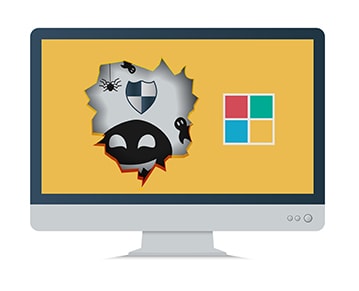A logic bomb is a sequence of code that’s deliberately put into a program to trigger when a logical condition is met, resulting in a spectrum of malicious threats. Logic bombs may be part of worms or viruses or within standalone programs. Typically concealed or buried in legitimate code, logic bombs remain dormant until the requirements are met, making the code extremely difficult to detect. A successfully detonated logic bomb can result in system failure, hard drive auto-deletion and data tampering, among other things.
Generally, this malware is written by the software’s developer, and attackers use the software development lifecycle to introduce a logic bomb.
Table of Contents
What Is the Definition of a Logic Bomb?
The term logic bomb refers to the code’s “explosion” when a specified event occurs, such as a specific date or time, the deletion of a specific record—for example, an employee—from a system, or the opening of the infected software application.

Also called “slag code,” a logic bomb frequently remains undiscovered until the function is executed or payload is launched. Logic bombs are also sometimes referred to as “code bombs” and “cyber bombs,” and there is virtually an unlimited set of conditions that can trigger a logic bomb.
Additionally, the degree of destruction caused by a logic bomb varies significantly, ranging from losing files and distorting data to wiping out hard drives and causing program failure. The payload is usually unknown until triggered, which is why logic bombs are difficult to mitigate, much less prevent.
What Is the History of Logic Bombs?

The first logic bomb strike occurred in 1982 during the Cold War between the United States and the former Soviet Union. The U.S. Central Intelligence Agency was allegedly notified that a Russian KGB employee had stolen designs and software for an advanced control system from a Canadian corporation intended for use on a Siberian pipeline. According to reports, the CIA had a logic bomb coded into the system to sabotage the adversary.
In 1988, a software contractor developed a logic bomb in response to a disagreement with an Oklahoma trucking company; the contractor threatened to detonate the logic bomb if the client did not pay invoices. The matter proceeded to trial, where the client eventually prevailed.
How Are Logic Bombs Used?
While most logic bombs have been planted by programmers to cause harm to employers, some companies can also hack customers using logic bombs.
The methods that describe how logic bombs can be delivered to infect devices are listed below.

- Logic Bomb Viruses
Computer viruses, worms and trojan horses may contain logic bombs. Logic bomb viruses are capable of concealing arbitrary code, allowing remote access to the device. Upon opening the malicious software, the attacker gains access and can do as much damage as desired. Alternatively, the virus can be used to infiltrate systems and networks, and then the logic bomb carries out various nefarious functions. Malicious activities include deleting or stealing data, invalidating or corrupting data, utilizing available system resources, restricting or prohibiting user access, and creating backdoors for hackers.
- Legitimate Code Bombs
These logic bombs are embedded in legitimate apps or processes on a network and remain dormant until triggered. Logic bombs are either introduced by malevolent insiders with network access or concealed in third-party dependencies taken into the network at some point in the software supply chain.

One case of a code bomb being caused by an individual occurred in 1991 when a former computer programmer at defense contractor General Dynamics was jailed for planting a logic bomb that was set to detonate several months after resignation. Without another General Dynamics employee detecting the device, the logic bomb would have destroyed valuable data on numerous defense contracts.
For a logic bomb by a company: In 2005, Sony was embroiled in a scandal over the release of CDs that contained a logic bomb. When the CDs were inserted into a computer, a logic bomb was triggered and subsequently installed a rootkit that prevented the computer from copying the CDs.
What Are the Different Types of Logic Bombs?
Hackers can employ logic bomb attacks in a variety of methods. The different types of logic bombs are given below.

- Backdoor: A backdoor is when a programmer develops a mechanism for granting any user future access to a system. This is frequently done compassionately to simplify programming by eliminating the need to constantly log in with user credentials. It also offers a mechanism for subsequent access if a client gets locked out of the system. However, backdoors may have unforeseen consequences, including vendor access after the system is implemented. This is when logic bombs may be planted into the software, waiting to be triggered.
- Game-thief trojan: A trojan is any malicious software that is set up as something innocent or seemingly unsuspicious. A game-thief trojan is designed to target online gamers’ login and user account details. While a trojan may appear harmless, it can perform various malicious operations once installed.
- Keylogger: With a keylogger, hackers obtain personal information by utilizing a combination of malware and logic bombs. For instance, a logic bomb may wait for a particular website or application to launch. The logic bomb would then initiate the activation of a keylogger. Any personal information entered will then be transmitted directly to the hacker.
- Counterfeit or cloned software: In this form of attack, harmful code is pre-installed on the software. When that particular software is launched, the logic bomb will automatically detonate.
What Can Trigger a Logic Bomb?
A negative or positive trigger can detonate a logic bomb. Whether the condition is positive or negative, the logic bomb will detonate and inflict damage if fulfilled unless a solution is discovered to mitigate the condition or remove the code.
1. Logic Bomb With Positive Trigger
A positive trigger requires a condition to be met before detonating a logic bomb. The trigger could be opening a particular file or program on a computer, arriving at a specific time or date, or logging in to a particular account. Once fulfilled, any event or criteria set by the programmer becomes a positive trigger to a logic bomb’s detonation.
2. Logic Bomb With Negative Trigger

Conversely, a negative trigger requires a condition not to be met before detonating a logic bomb. For instance, a programmer could include code in a payroll application that deletes files if a name does not appear on the list so that an employee’s dismissal instantly removes specific files.
An employee not logging in for a specific number of days can also be an example of a negative trigger. Finally, the logic bomb can immediately detonate when it is not deactivated within a specific time frame.
What Are the Examples of Logic Bombs?

There are numerous examples of logic bombs both in the private and public sectors, with some of the earliest cases appearing in the early 2000s.
In 2002, an unhappy UBS PaineWebber employee named Roger Duronio successfully detonated a logic bomb against the Swiss financial services company. The bomb was designed to go off at 9:30 a.m. on March 4, 2002, after the UNIX shell command recursively deleted the root partition, including all files and subdirectories. The logic bomb compromised 2,000 servers located in 400 branch offices, rendering thousands of the company’s brokers unable to execute deals. The employee was eventually apprehended and sentenced to a minimum of eight years in federal prison with a $3.1 million restitution to UBS.

Logic bombs have also impacted the public sector. In 2018, the U.S. Army was the victim of a logic bomb assault that erased large amounts of data, preventing Army reservists from being deployed and paid on schedule. After spending more than $2.5 million to examine and repair systems, the Army finally restored the data. The culprit was sentenced to prison and compelled to pay restitution totaling $1.5 million.
In 2019, Siemens contract programmer David Tinley was found guilty of implanting a logic bomb into the system built to elicit service calls and bill customers for resolution. Tinley inserted these logic bombs into the customized, automated spreadsheets built, resulting in errors and resizing on-screen buttons. The contractor “resolved” the issue—and defrauded the client—by delaying the date on which the spreadsheets would cease to function. When apprehended, the programmer was fined and imprisoned.
What Are the Statistics About Logic Bombs?

In the 2003 CSI/FBI Computer Crime and Security Survey, hackers were reported as the primary source of logic bomb attacks, while disgruntled employees ranked second on the list. The percentages were 82% and 77%, respectively.
Since logic bombs fit into the broader category of trojans and viruses, the statistics about this attack technique tend to overlap with other cybercrimes. In 2020, the Federal Bureau of Investigation’s Internet Crime Complaint Center reported the following noteworthy statistics.
- A daily average of over 2,000 complaints are received.
- Victims recorded $4.2 billion in losses.
- In the last five years, the average complaints exceed 440,000 annually.
- Victims over the age of 60 are the highest.
- Outside of the U.S., the United Kingdom is the top target victim country.
- In the U.S., California and Florida top all states with the highest number of victims.
Which Devices Can Logic Bombs Infect?
Malware can infect any electronic device equipped with a CPU, an operating system and memory. Logic bombs may infect any device, despite the assumption that some gadgets are more secure than others.The virus can be rather severe when a vulnerability permits code to execute as part of a working exploit. Examples of devices and the effects of logic bombs on each are discussed below.

- PC/Windows
Microsoft’s Windows is the most extensively used operating system globally, operating in the desktop, tablet and console markets. An attack on a Windows platform would affect many companies because a successfully triggered logic bomb on a computer can cause system failure, auto-deletion of hard drives or data manipulation.
- MacOS
The Apple operating system is more secure than many versions of Windows. However, connected software, plug-ins and add-ons might create security flaws for users. The most popular method of attacking a macOS-run device is through a third-party browser and browser plug-ins such as Adobe Reader, Flash or Java. Most Mac users have these plug-ins installed and enabled on computers, jeopardizing the system’s overall security. While a Mac is less susceptible to infections, users may still fall prey to trojan horses, phishing schemes, online fraud and other threats.
- iPhone/iOS
iPhone infections are exceedingly rare. iPhones are normally secure but can become infected with malware if “jailbroken.” Jailbreaking entails getting root capabilities to circumvent the security limitations that ordinarily prevent applications from operating on the system. Jailbroken iPhones grant users increased power over the operating system, making the phone less safe and prone to be targeted by dangerous applications.

Another possible entry point is a few flaws previously identified in the WebKit browser engine, which Safari uses as the default browser on Apple devices. Apple believes this can result in the execution of arbitrary code on vulnerable devices. The company identified a kernel vulnerability, a race condition error that might be exploited to elevate a process’s privileges. Per existing information, unknown individuals may have already exploited the vulnerabilities.
Note:
To safeguard Apple iOS devices, do not jailbreak any device. Update all iPhones and iPads to the latest version available. If the device is older and does not support the latest version, install another browser and set that as the default.- Android Mobile Devices
Android is the most popular mobile platform today and the most extensively targeted mobile operating system by malware. Static analyses now effectively detect the presence of the majority of malicious code and undesired data flows. On Android devices, logic bombs typically carry out malicious purposes by violating permissions, utilizing permission for an activity that the user did not authorize.

One example of a logic bomb attack on Android devices happened in July 2015 against HackingTeam, a security company. After a series of events, RCSAndroid was identified. One of the most sophisticated Android malware samples ever discovered, RCSAndroid is capable of leaking the victim’s private conversations, GPS location and device tracking information. It also captures screenshots, obtains information about online accounts and intercepts real-time voice calls.
Upon noticing usual indicators of malware infection, the first thing to do is shut down the Android device. Shutting down the phone stops additional damage and distribution of harmful software to other programs. Navigate to the “Settings” menu and access “Device Administrator,” disable malware access, reset the device’s settings or locate and delete the suspected application.
Are Logic Bombs Illegal?
Several developers incorporated a logic bomb into software products between 1980 and 1985. Such logic bombs were programmed to destroy the software if the license was not renewed. Today, this practice and other forms or purposes of logic bombs are considered illegal.
What Are the Laws Regarding Logic Bombs?

Several cybersecurity laws are currently enforced. Some examples in the U.S. are the Computer Fraud and Abuse Act (CFAA) enacted in 1986 and the Computer Virus Eradication Act of 1989. These laws protect federal, bank and other computers from threats, damage, espionage, trespassing and from being used corruptly for fraud. There have been convicted felons for acts on logic bombs.
The federal law is not a comprehensive provision but instead fills cracks and gaps in the protection afforded by other federal criminal laws.
How To Protect Yourself From a Logic Bomb
Implementing preventive measures helps to ensure that a network or device is not compromised with a logic bomb attack. Some actions that may help prevent a logic bomb from being used on a system are listed below.

- Securely configure the system. Obtain a hardening guide online for the majority of platforms. Additionally, ensure that a unique password is used for each account on each host with limited failed login attempts.
- Give users only the authority required and constantly assess the rights to ensure that a certain user’s assault range is limited.
- Maintain an up-to-date knowledge base. A user may attempt to obtain access via a privilege escalation mechanism. Regularly patching the system may be more challenging.
- Create a baseline of known processes operating on each host at any given time. Regularly compare the baseline to the current view to assist in locating any rogue processes on the system.
- Use a software integrity checker to determine whether any software has been updated to include a logic bomb.
- Verify that no unknown jobs are scheduled in the scheduler.
- Conduct a review of the log for patterns or unusual activities.
- Ensure that all hosts (workstations and servers) are protected with an up-to-date antivirus that uses heuristic and pattern recognition to detect and block known “destructive malware,” as well as unknown threats. This step boosts the resilience of the entire network. Keeping the antivirus updated will protect users from any attack that may disguise itself as something harmless.
- Schedule periodic scans for the entire device. Logic bombs are usually hidden among code, so one must be vigilant with all file types, especially compressed or zipped files.
- Buy original software instead of using pirated programs or disreputable freeware. Though saving money is tempting, getting the original and legitimate software will prove to be the prudent move if any data is compromised by the alternative software.
- Train employees on how to identify phishing emails and have a protocol for when one is spotted.
- Practice safe internet behavior. Avoid unsecured web links, which may end up directing to a website that is compromised. Avoid all suspicious links or email attachments at all costs.
- Keep the operating system updated. Updates will install patches to close off system vulnerabilities.
What To Do If You Become a Victim of a Logic Bomb
Respond quickly to a suspected or actual logic bomb attack by following the steps given below.

- Analyze the situation. The severity of the payload of a logic bomb varies greatly. Check for types of theft or fraud that need to be addressed.
- If a device is used to access sensitive online accounts and has been infected with harmful computer programs, a hacker may enter to take confidential data. Examples are login details for online transactions, such as banks, credit cards and other sensitive identity-tied information. If a computer is potentially affected, run antivirus software to check for and delete any infections.
- Check financial accounts for unauthorized activities.
- File a report with the FBI’s Internet Crime Complaint Center. As proof of the crime, file a police report as well.
- Work with agencies to remove fraudulent files or activities on your system or device.
- Contact the local FBI field office to request assistance or submit a tip online.
How To Remove a Logic Bomb
Remove the code if a logic bomb is suspected to be in the system. The steps one can take to stop a logic bomb from causing any potential harm are described below.

- Run Microsoft Windows Defender, which is a proprietary piece of software bundled with Windows 10. The program will scan the computer for any programs or files that may risk or potentially harm the system.
- Click the Windows icon at the lower left of the screen and click on the “Settings” icon.
- Once in Settings, click on the “Update & Security” icon.
- Click on Windows Security, and under the heading Protection areas, select “Virus & Threat Protection.”
- A notice says “Current threats,” and under it, click on “Scan options.”
- Under the next selection, various options for malware detection will appear. At this point, save all the progress in all open applications. The options are (a) Quick scan, (b) Full scan, (c) Custom scan, and (d) Windows Defender Offline scan. Once the choice is made, click on “Scan now.”
- A progress bar will appear with the estimated time remaining.
- After the scan is finished, a summary will be displayed. Depending on the results, decide whether the scan and process were sufficient or if something else needs to be done. Usually, if a threat is found, there will be a recommended action to flag the file on how severe and destructive the virus is. Click on “Start actions.”
- The next step is to diffuse the logic bomb. When a logic bomb needs to be diffused and removed from the host, ensure that a damaged system is restored to a lab environment where experiments that could potentially kill the system can be done.
- A few days before the incident, reset the clock to ensure that the bomb does not re-explode while attempting bomb dispersion. This will be useful with a ticking time bomb. Set the clocks back by a small amount. Program the bomb to compare the system time to the timestamp of the file. If the timestamp is greater than the system time currently in use, the bomb may be designed to detonate.
- Install packet sniffers on the machine. If the bomb attempts to communicate with a remote host for any reason (maybe the triggering occurs when a condition on a remote system is met, or if the payload is configured to execute on a remote machine), trace the communication and locate the executable of the tainted code.
- Analyze the log files. The system logs are brimming with tasty information, so avoid allowing any irritating detail to pass without performing a thorough and valid review.
- Conduct a check of all running processes, scheduled jobs and programs that are executed at startup. Because the bomb must begin somewhere, carefully evaluate each entry and validate the integrity of each file by comparing the same to a known clean version.
- Finally, if in doubt, consult a forensic expert to locate and remove the slag code.
- Bring the service back online. Reconnect the system to the network. It’s prudent to maintain a close eye on the system over several months to ensure nothing was missed during the bomb removal process.
What Are the Tools To Defend Against a Logic Bomb?
Investing in the best antivirus software available is the first step toward maintaining online security. The simple-to-use software continues to be the best line of defense against fraudsters looking to expose online data for financial gain. Fortunately, antivirus software offers impenetrable security, additional features to keep devices safe from scammers, and is easy to install and operate. The best available software programs to defend against a logic bomb are listed below.
- Avast Antivirus – What is Avast?
- Avira Antivirus
- Bitdefender Antivirus – What is Bitdefender Antivirus?
- Kaspersky Antivirus – What is Kaspersky Antivirus?
- McAfee Antivirus
- Norton Antivirus – What is Norton Antivirus?
- Sophos Home – What is Sophos Home?
- Trend Micro Antivirus
- Webroot SecureAnywhere Antivirus – What is Webroot SecureAnywhere Antivirus?
What Are the Differences Between Logic Bombs vs. Time Bomb Attacks?

Time bombs are a subcategory of logic bombs. A standard logic bomb detonates when a given event or condition happens, while a time bomb is a ticking bomb programmed to detonate at a predetermined time or date. A logic bomb must be triggered to detonate, whereas a time bomb will detonate regardless of the circumstances unless the code is halted.
Occasionally, the term “time bomb malware” refers to time bombs, albeit a misnomer. As with logic bombs, time bombs conceal themselves among various types of malware, although not technically malware. Though technically incorrect, the term “time bomb virus” is frequently used to refer to a virus that contains a time bomb.
What Are the Other Threats?
Scammers and hackers use various methods to get information or cause potential damage to others. Other threats that can be identified and avoided are given below.

- Doxxing (or doxing) is the practice of uncovering and releasing anyone’s information online, referring specifically to exposing the true person behind an anonymous handle or login. Doxxing attacks are typically motivated by harassment or vengeance and occasionally by a sense of vigilante justice, such as doxxing individuals to expose racist or neo-Nazi comments made anonymously online.
- Phone number spoofing or caller ID spoofing is when a caller (a scammer or hacker) attempts to mimic a trusted contact or authority by using a faked local or well-known number. The specific purposes of phone spoofing are to get sensitive personal information or defraud the victim of money.
- Apple ID phishing scams are when fake Apple emails pose as official Apple correspondence to trick users into revealing Apple ID passwords and other account information. An Apple account holds personal contact data, payment details and security information to access Apple services and access photos, devices, contacts and streaming accounts.
Logic bombs continue to be a viable strategy for attackers, necessitating the adaptation of security safeguards. While multiple mitigations for logic bombs have existed for years, logic bombs have evolved with the development of new tools and attack methods. Strict measures are therefore critical to safeguarding the system and the network. By applying the recommended tools to defend against logic bombs, organizations should detect and prevent logic bomb assaults in the future.

